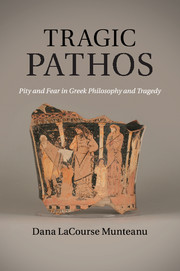Book contents
- Frontmatter
- Contents
- Preface and acknowledgments
- List of abbreviations
- Introduction
- Part i Theoretical views about pity and fear as aesthetic emotions
- Part ii Pity and fear within tragedies
- Chapter 5 An introduction
- Chapter 6 Aeschylus: Persians
- Chapter 7 Prometheus Bound
- Chapter 8 Sophocles: Ajax
- Chapter 9 Euripides: Orestes
- Appendix Catharsis and the emotions in the definition of tragedy in the Poetics
- Bibliography
- Index
Chapter 5 - An introduction
Published online by Cambridge University Press: 05 December 2011
- Frontmatter
- Contents
- Preface and acknowledgments
- List of abbreviations
- Introduction
- Part i Theoretical views about pity and fear as aesthetic emotions
- Part ii Pity and fear within tragedies
- Chapter 5 An introduction
- Chapter 6 Aeschylus: Persians
- Chapter 7 Prometheus Bound
- Chapter 8 Sophocles: Ajax
- Chapter 9 Euripides: Orestes
- Appendix Catharsis and the emotions in the definition of tragedy in the Poetics
- Bibliography
- Index
Summary
Purpose of survey
Developmental psychologists have found that infants feel sympathetic distress before they fully realize that they exist apart from other people. Even a few months after birth, infants react to a disturbance in those around them as though it were their own, crying when they see another child's tears. By one year or so they start to realize the misery is not their own but someone else's, though they still seem confused over what to do about it.
(Daniel Goleman, Emotional Intelligence, New York, 1998, 98)Modern studies show that we are wired to feel sympathy for the suffering of another, and ancient Greek thinkers deemed pity the fundamental response to the human suffering represented in tragedy. But what are the features of pity in tragedies? Do the internal viewers invariably feel pity when they witness suffering? Is pity accompanied by fear, as Gorgias, Plato, and Aristotle have suggested? What kind of fears do the internal spectators express? Thus far, I have discussed theoretical views about pity and fear as tragic emotions in fifth- and fourth-century Athens. Ancient authors defined the effect of tragedy on the audience mainly in terms of emotion, pleasure, and cognitive stimulation, although different authors gave these characteristics varying degrees of emphasis and different nuances of meaning. My focus has been on less explored aspects of Aristotelian theory, which proposes an integrative response to tragedy, both emotional and cognitive, and thus conducive to pleasure. In this second part I will assess pity and fear as emotional responses within tragedies, ranging from early Aeschylean to late Euripidean, by examining how, why, and when internal audiences (the chorus and various characters) express the two emotions. The purpose is twofold. On the one hand, I am interested in comparing internal expressions of pity and fear to the theoretical descriptions of the emotions of the preceding chapters. To this end, the differences between the tragic expressions and the philosophical accounts are as important as the similarities. On the other hand, I concentrate on possible links between the expressions of pity and fear within tragedies and the responses of the external audiences. Despite their differences, Gorgias, Plato, and Aristotle generally assume that pity is an emotion that the Athenians feel naturally when watching tragedies. But is this an unquestionable truth? Moreover, how does fear depicted in tragedies relate to pity? What types of fears are expressed in tragedies? The focus of my analysis will be especially on the manner in which internal audiences debate pity as an appropriate response to suffering and the relevance of such disputes over pity for the contemporary fifth-century Athenian audiences. In all cases, I discuss first modern scholarly views about a play's ability to stir the sympathy of the Athenian audience, then examine the internal perspectives on tragic suffering, and conclude with an appraisal of how these internal viewpoints might have been received by the contemporary spectators.
Information
- Type
- Chapter
- Information
- Tragic PathosPity and Fear in Greek Philosophy and Tragedy, pp. 141 - 150Publisher: Cambridge University PressPrint publication year: 2011
